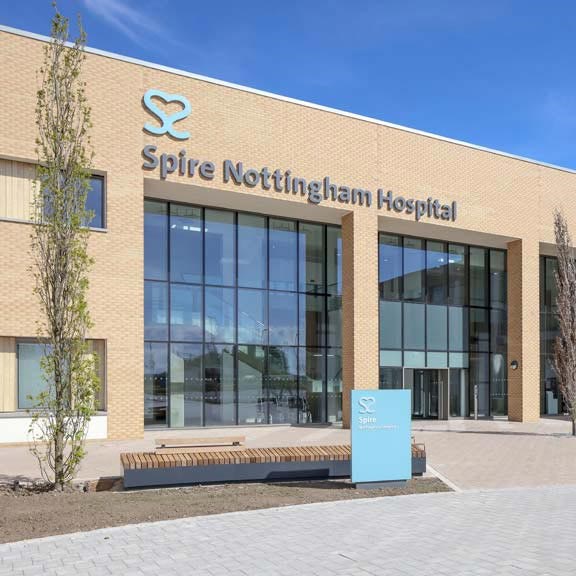Joint pain treatment (joint injections)
Steroid injections to help ease pain and increase movement.
Our expert teams offer injections for inflamed, swollen joints in a quick procedure to help ease chronic joint pain and stiffness.
Sometimes also called
- Corticosteroid injections
- Hydrocortisone injections
- Intra-articular injections
- Steroid injections
At a glance
-
Typical hospital stay
1-2 hours -
Procedure duration
20 minutes -
Type of anaesthetic
Sometimes local is used -
Available to self-pay?
Yes -
Covered by health insurance?
Yes
Why Spire?
- Fast access to diagnostic tests and scans
- Wide range of treatments offered
- Transparent pricing
- 98% of our patients are likely to recommend us to their family and friends
Joint pain can be both very unpleasant and prevent you doing everyday things such as walking, writing, exercise or sport.
The injection of steroids (possibly mixed with a local anaesthetic) into the joint can provide rapid pain relief for several weeks or months. You will usually be sedated (given a calming drug) but occasionally people are asleep during the procedure following a general anaesthetic.
Why you might need it
Injury or arthritis can cause debilitating pain that affects your enjoyment of life. As well as being in pain, joint pain can prevent you from taking part in everyday activities like:
- exercise or sport
- playing with your children and family
- driving
- using computers for work or leisure
A joint injection can provide relief from a swollen knee, foot pain, sciatica, trigger finger and Morton's neuroma. Some people enjoy this relief for several months while others require new injections every few weeks.
Your expert consultant may also inject a local anaesthetic, mixed with the steroid in the same syringe. Local anaesthetic drugs block the way nerves carry pain signals to your brain. This provides instant pain relief at the time of the injection. If your consultant only injects steroids you will feel the full benefit after a few days.
The procedure takes around 20 minutes, including time for a sedative to take effect.
We have modern, well-equipped hospitals and clinics and practice some of the latest, advanced medical treatments. We take an integrated approach so we can organise any other care that you may need to help ease your joint pain, like physiotherapy, for your procedure.
If you decide to have your procedure with us, you will be looked after by an experienced multidisciplinary care team.
Find a Spire hospital offering this treatment

Who will do it?
Our patients are at the heart of what we do and we want you to be in control of your care. To us, that means you can choose the consultant you want to see, and when you want. They'll be with you every step of the way.
All of our consultants are of the highest calibre and benefit from working in our modern, well-equipped hospitals and clinics.
Our consultants have high standards to meet, often holding specialist NHS posts and delivering expertise in complex sub-specialty surgeries. Many of our consultants have international reputations for their research in their specialised field.
Before your treatment
You will have a formal consultation with a healthcare professional. During this time you will be able to explain your medical history, symptoms and raise any concerns that you might have.
We will also discuss with you whether any further diagnostic tests, such as scans or blood tests, are needed. Any additional costs will be discussed before further tests are carried out.
Preparing for your treatment
We've tried to make your experience with us as easy and relaxed as possible.
For more information on visiting hours, our food, what to pack if you're staying with us, parking and all those other important practicalities, please visit our patient information pages.
Our dedicated team will also give you tailored advice to follow in the run up to your visit.
The procedure
We understand that having any medical procedure, even one as relatively straightforward as a joint injection, can cause anxiety. Our professional and caring medical staff will be there to reassure you throughout.
Once the sedation has taken affect and you're feeling very calm, your expert consultant will feel and flex the joint. If you have arthritis your consultant may need to draw out fluid through a needle before injecting the medication.
An X-ray machine is likely to be positioned over the joint to help guide the consultant to the exact spot for the steroid injection. Your consultant will insert a thin needle into the joint and the steroid (and local anaesthetic if one is being used) will be injected. Your consultant may make more than one injection in the same session if appropriate.
The whole procedure, including sedation, takes around 20 minutes.
Aftercare
After the procedure, you will be taken to your own recovery room or a dedicated recovery area where you can relax in comfort until you’re able to go home - generally half an hour.
If a local anaesthetic was injected with the steroids the pain should disappear immediately. Otherwise you should feel the full benefit after a few days.
Your consultant will talk to you about the possible risks and complications of having this procedure and how they apply to you.
But everyone is different. If you have any questions or concerns, we’re ready to help.
Why choose Spire?
We are committed to delivering excellent individual care and customer service across our network of hospitals, clinics and specialist care centres around the UK. Our dedicated and highly trained team aim to achieve consistently excellent results. For us it's more than just treating patients, it's about looking after people.
Important to note
The treatment described on this page may be adapted to meet your individual needs, so it's important to follow your healthcare professional's advice and raise any questions that you may have with them.
Procedures carried out at Spire Healthcare Clinics will be performed under local anaesthetic.
What is a joint injection?
Joint injections are a quick procedure to inject hydrocortisone (a type of steroid) directly into an inflamed, swollen joint. Damage or injury to a joint can cause chronic joint pain and make it harder to enjoy everyday activities such as:
- Driving
- Playing sport
- Walking around easily
Conditions that may cause joint pain include:
- Arthritis
- Bursitis (housemaid’s knee)
- Osteoarthritis
- Tendonitis (tennis elbow)
A joint injection could benefit you by reducing inflammation and swelling in the affected joint, especially if you're experiencing:
- Elbow pain
- Hip pain
- Knee pain
- Shoulder pain
- Wrist pain
After a joint injection, your pain should improve and you can move your joint more easily, allowing you to get back to your usual routine. If you don’t think injections are for you, hydrocortisone can also be received in the form of skin creams, foam and tablets.
These steroids are only available with a prescription. Before recommending joint injections, your GP will ask about your general health and may check your blood pressure and blood sugar, as hydrocortisone can raise these.
You’ll also need to let your GP know if you have diabetes, glaucoma or osteoporosis, as hydrocortisone can worsen these conditions. Hydrocortisone isn't suitable for everyone, so you should tell your GP if you:
- Are allergic to hydrocortisone or other medicines
- Have depression or bipolar disorder, or if any members of your family have these illnesses
- Have an infection, or have recently come in close contact with somebody with chickenpox, measles or shingles
- Are trying to conceive, currently pregnant or you’re breastfeeding
- Have recently had or will soon have any vaccinations
You won’t have to wait long to find out if joint injections are right for you, and if you have more than one painful joint you can discuss whether to have them treated at the same time. Don’t worry if this procedure isn’t for you as there are plenty of alternative treatments available instead of joint pain injections, such as anti-inflammatory tablets and physiotherapy.
Find your nearest Spire hospital or clinic
Almost all our hospitals offer private joint injections and have teams of specially trained doctors who specialise in these procedures. Joint injections may also be offered at one of our Spire Healthcare Clinics.

Events
Free knee pain information evening, with Orthopaedic Surgeon Mr Ganapathi
Join our free information evening, understand your knee pain, treatment options and see the ROSA knee robot in action!
Learn more
Free patient information evening for knee pain with Mr George Tselentakis
Join Consultant Orthopaedic Surgeon, Mr George Tselentakis for an evening talk.
Learn more
Free patient information evening for hand and wrist pain with Mr Bhat
Join Consultant Orthopaedic and Upper Limb Surgeon, Mr Murali Bhat for an evening talk.
Learn more
How joint injections work
Joint injections contain hydrocortisone, a type of steroid called a corticosteroid, which slowly suppresses the chemicals that cause inflammation. This is different from an anabolic steroid, which is the type that helps increase your muscle mass.
A consultant carries out an intra-articular injection where the hydrocortisone is injected directly into your joint. This helps the treatment work faster and reduces the risk of any side effects.
The dose of hydrocortisone you’ll receive depends on the size of your joint, you can expect it to be anywhere between 5mg and 50mg.
Your doctor may use a local anaesthetic to numb the injection site so you don’t feel any pain from the injection itself. Your doctor may also perform an aspiration and remove synovial fluid from your joint before your hydrocortisone injection.
Some people find their joint pain improves hours after their injection, but it can take a few days. You can expect the effects to last for a few weeks or up to a year, depending on the type of injection you have. If needed, you can receive hydrocortisone injections in the same joint for up to four times in the year, but any more than this could cause irreversible joint damage. Your doctor will discuss how much hydrocortisone you need, depending on how severe your chronic pain is and your general health.
What to expect during joint injections
Who will be involved?
An orthopaedic surgeon or consultant radiologist can inject the hydrocortisone into your joint. There may also be a nurse or assistant at your appointment.
How to prepare for a joint injection
If you take blood-thinning medication, you may need to stop taking these in the days building up to your joint injection as they can increase your risk of bleeding and bruising. You should also tell your doctor if you have any conditions that affect how well your blood clots. You may need to stop taking other medications and supplements too, but your consultant should’ve discussed this with you.
You can eat and drink as normal before your treatment, but you must tell us if you have diabetes as the injections could increase your blood sugar levels. You can wash before your treatment but must not apply any cosmetic products, including any prescribed creams or rubs for your joint pain.
It’s a good idea to wear loose and comfortable clothing with easy access to the joint being injected. You may also be asked to sign a consent form.
How long do joint injections take?
Joint injections usually take around 20 minutes. They may take longer if your doctor decides to perform an ultrasound scan to help target the inflammation precisely.
Anaesthetics
Before the procedure you may be given a sedative, so you feel very calm. Your doctor may numb the area by injecting some local anaesthetic into your joint. Sometimes they may combine the anaesthetic and hydrocortisone in the same syringe, so you only need one injection.
Pain after joint injections
You’re likely to feel some pain afterwards from the injection itself. If you had a local anaesthetic during the treatment, this will help with the pain but will wear off after a couple of hours. You can apply an ice pack around your joint to relieve pain but you should avoid heating pads. You can also take over-the-counter painkillers for pain management, such as:
- Ibuprofen
- Paracetamol
It's a good idea to arrange to have a lift home because the numbness from the local anaesthetic and discomfort from the injection can make it difficult to drive.
Any discomfort or bruising you feel around your joint afterwards should go after a few days, and you should be free of the chronic pain caused by your inflamed joint.
Recovering from joint pain treatment
You’ll be able to go home a couple of hours after your injection. It’s best to avoid any heavy exercise and rest your joint for a couple of days until any pain from the injection has gone. After this, you can begin to move and exercise your joint as the hydrocortisone should have taken effect and the pain and stiffness in your joint should have improved. Your doctor will advise on when to return to work if you have a strenuous job.
You could benefit from physiotherapy once you’re pain-free and can exercise your injected joint more easily. Your physiotherapist can show you exercises that will help to strengthen your joint.
Risks and complications of joint injections
Most people have no complications from their joint injection, but as with most medical procedures, they are possible. Common short-term side effects of your injections include:
- Intense pain and swelling – though this should go away after a couple of days
- Bruising around the joint
- Facial flushing
In rare cases, hydrocortisone from your injected joint can reach the bloodstream. This is more likely if you have repeated injections. If this happens, there’s a very small risk of developing more serious complications. If you believe you have any of these side effects, call your doctor right away:
- Depression – including suicidal thoughts, mood swings, anxiety, or strange and frightening thoughts
- High blood pressure
- High blood sugar – you may feel sleepy, confused, hungry or thirsty, as well as experiencing changes in your urination frequency, breathing and breath
- Infection – you may have a fever (temperature over 38°C), chills, or pains around your throat, ear, and sinuses
- Osteoporosis – weakened and fragile bones
- Thinning skin
- Signs of Cushing’s syndrome – weight gain in the upper back, belly or face, headaches and slow wound healing
Your doctor will talk these through with you so you can make an informed choice about the benefits and any risks of your course of treatment and will monitor you throughout. You should also call your doctor if you feel breathless, have swollen arms or legs, or experience changes in your eyesight following your injections.
In some cases, steroid injections can increase your blood sugar levels for up to a week after the procedure. If you have diabetes, you should carefully monitor your blood glucose levels during this time and call your doctor if you have any concerns.
Hydrocortisone can cause problems in the first trimester (12 weeks) of pregnancy and you should talk to your doctor if you’re trying to conceive or if you’re already pregnant before having an injection. It may also interfere with your menstrual cycle. Otherwise, it’s safe to have joint injections while breastfeeding.
Some medicines can interfere with the way that hydrocortisone works, so it’s important to speak to your doctor or pharmacist before starting or stopping any medicines, herbal remedies, vitamins or supplements.
At Spire hospitals, your safety is our top priority. We have high standards of quality control, equipment and cleanliness and a rigorous system of review and training for our medical teams.
Treatment and recovery timeline
Although everybody’s different and you should always follow your consultant’s advice, here’s a typical recovery timeline for joint injections:

1-2 hours
Leave hospital or clinic
1-2 days
Rest at home
2 days
Begin moving and exercising your joint
A few days
Start to feel benefits
A few weeks to a year
May still feel the effects
-
1-2 hours
Leave hospital or clinic
-
1-2 days
Rest at home
-
2 days
Begin moving and exercising your joint
-
A few days
Start to feel benefits
-
A few weeks to a year
May still feel the effects
Frequently asked questions
How do joint injections work?
Joint injections contain hydrocortisone which is a specific type of steroid called a corticosteroid. The injections gradually release hydrocortisone into the joint where it can suppress the immune system activity in the area which is causing inflammation. As a result, the pain and swelling go down.
When will I feel better?
The effects of the joint injection can work as quickly as a few hours, but most can expect to feel better after two to three days.
How many joint injections will I need?
You may only need one joint injection if your pain and swelling get better, but if you have a long-term problem you may need to have more. It is recommended that you don’t have hydrocortisone injections into the same joint more than four times a year.
Does it hurt?
You may have the injection under local anaesthetic so you shouldn’t feel any pain during the procedure. If you are not having anaesthetic you may experience a little discomfort.
How well do joint injections work?
Joint injections help with pain and swelling for several months, as well as improving the movement of the joint. In some cases, you may only need one injection, but if you have long-term joint pain you may need further injections.
Will I be at higher risk for infections?
As hydrocortisone in the injection acts to reduce the inflammation and pain in your joint by weakening your immune system, you can also be more at risk to infections.
Can I have vaccinations?
You can still have vaccinations after your treatment but you should mention this to your doctor or nurse first.
Can I drink alcohol with joint injections?
Yes, you can drink alcohol as normal before and after your treatment.
Are there any food or drinks I need to avoid?
You can continue to eat and drink as normal before and after your joint injection.
Will it affect my fertility?
Hydrocortisone joint injections will not affect the fertility of either men or women.
Will it affect my contraception?
Hydrocortisone joint injections will not affect any types of contraception.
Are other treatments available?
There are other types of medication for swollen and painful joints, such as painkilling creams or over-the-counter painkillers. Your doctor can also prescribe stronger painkillers such as codeine and naproxen. Physiotherapy and lifestyle changes have also been shown to be effective in reducing joint pain.
Can lifestyle changes help painful joints?
Lifestyle changes can help with your joint and you can seek advice from a physiotherapist or an occupational therapist about this. You may find that some changes in exercise, using a walking stick, or having electrotherapy can improve the pain and swelling in your joint.
Can my child have a joint injection?
Children can have joint injections, but if they are repeated over many months it may slow down their normal growth. Please talk to your doctor if you have any concerns surrounding this.
How often can I have a joint injection?
It is usually recommended that you shouldn't have more than four injections into the same joint over one year, any more than this may result in irreversible damage.
The treatment described on this page may be adapted to meet your individual needs, so it's important to follow your healthcare professional's advice and raise any questions that you may have with them.

